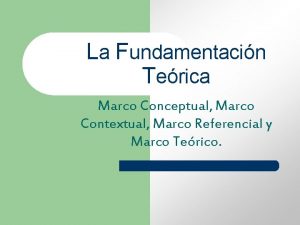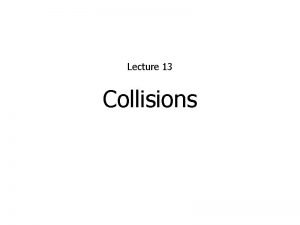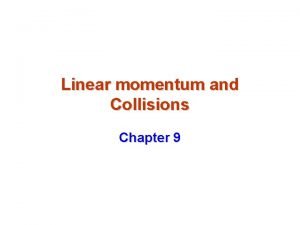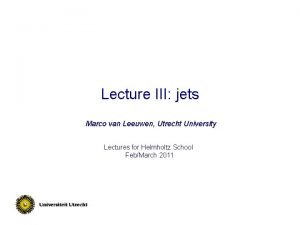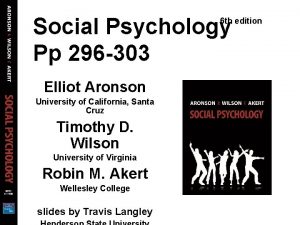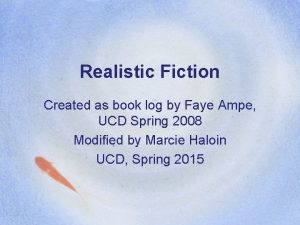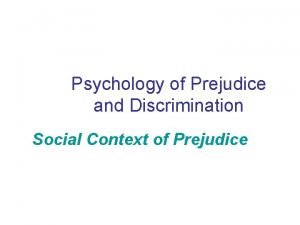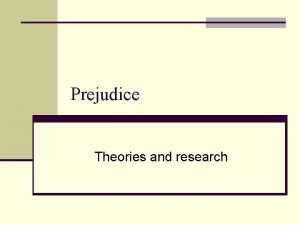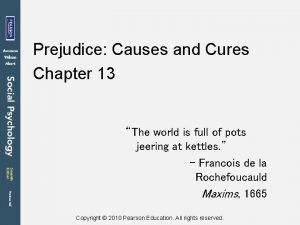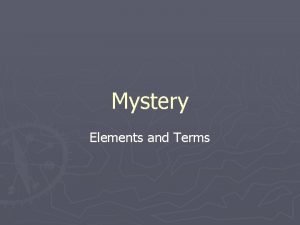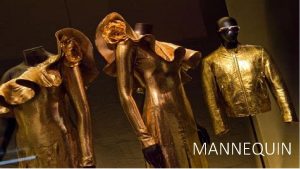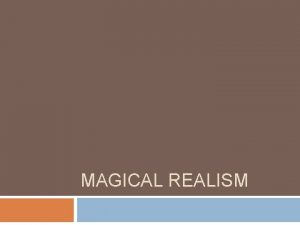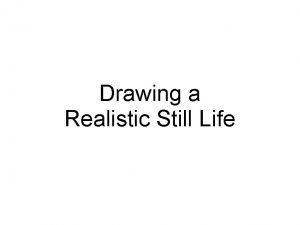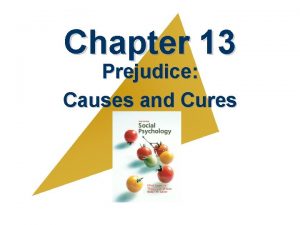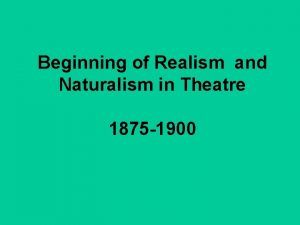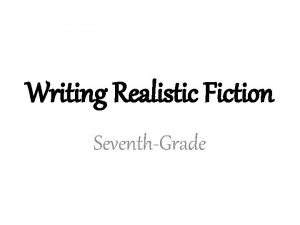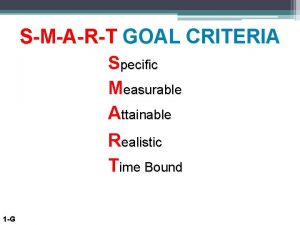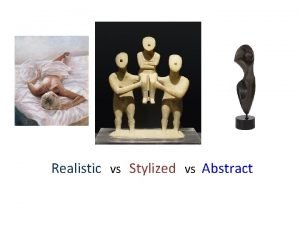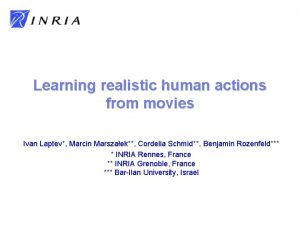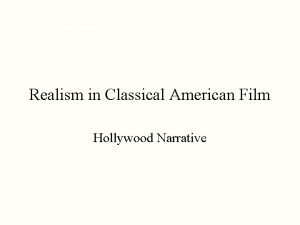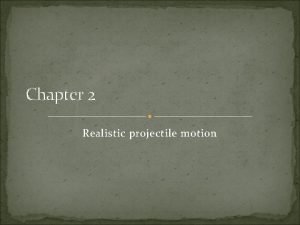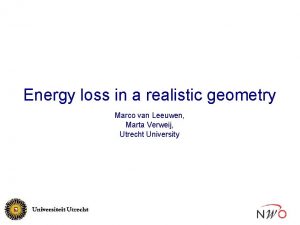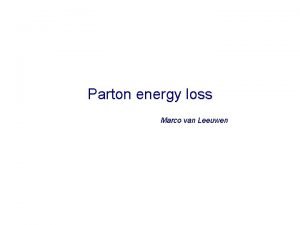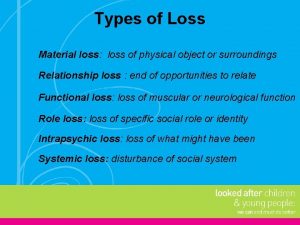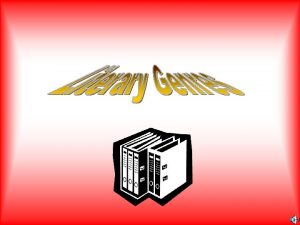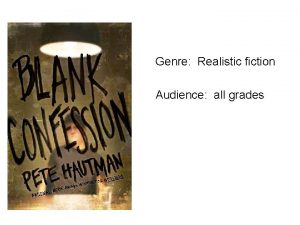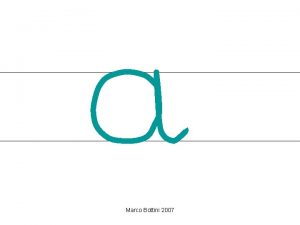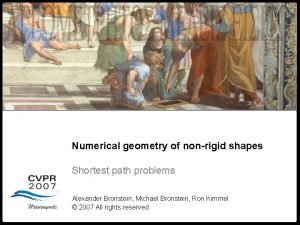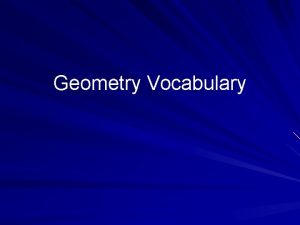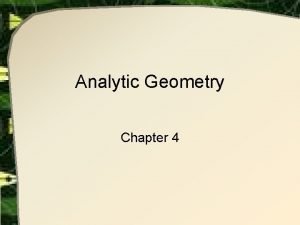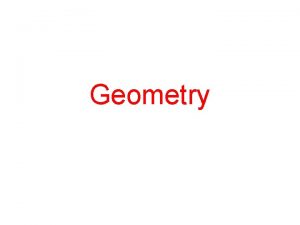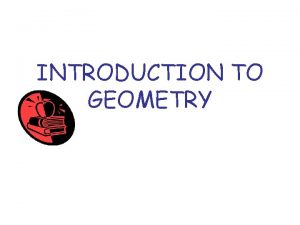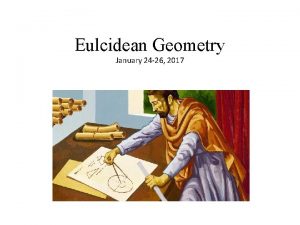Energy loss in a realistic geometry Marco van





















![Surface bias II: Ltrig vs Lassoc Leff [fm] For RAA and IAA different mean Surface bias II: Ltrig vs Lassoc Leff [fm] For RAA and IAA different mean](https://slidetodoc.com/presentation_image/3c087a667df39894af68251eaf8f22cc/image-22.jpg)

















- Slides: 39

Energy loss in a realistic geometry Marco van Leeuwen, Marta Verweij, Utrecht University

Soft QCD matter and hard probes Heavy-ion collisions produce ‘quasi-thermal’ QCD matter Dominated by soft partons p ~ T ~ 100 -300 Me. V Hard-scatterings produce ‘quasi-free’ partons Initial-state production known from p. QCD Probe medium through energy loss Use the strength of p. QCD to explore QCD matter Sensitive to medium density, transport properties 2

Plan of talk • Energy loss in a brick: reminder of main differences between formalisms • How do these carry over to full geometry • Surface bias? • Can we exploit full geometry, different observables to constrain/test formalisms? • Case study: RAA vs IAA • Some results for LHC 3

The Brick Problem Gluon(s) w k. T Compare energy-loss in a well-defined model system: Fixed-length L (2, 5 fm) Density T, q Quark, E = 10, 20 Ge. V 4

Energy loss models Multiple soft scattering approximation ASW-MS Phys. Rev. D 68 014008 Opacity expansions (OE) ASW-SH (D)GLV Nucl. Phys. A 784 426 AMY, HT only in brick part (discussed at JET symposium) 5

Some (overly) simple arguments p 0 spectra Nuclear modification factor PHENIX, PRD 76, 051106, ar. Xiv: 0801. 4020 This is a cartoon! Hadronic, not partonic energy loss No quark-gluon difference Energy loss not probabilistic P(DE) Ball-park numbers: DE/E ≈ 0. 2, or DE ≈ 2 Ge. V for central collisions at RHIC Note: slope of ‘input’ spectrum changes with p. T: use experimental reach to exploit this 6

Energy loss distributions ‘Typical for RHIC’ Not a narrow distribution: Significant probability for DE ~ E Conceptually/theoretically difficult ASW: Armesto, Salgado, Wiedemann WHDG: Wicks, Horowitz, Dordjevic, Gyulassy TECHQM ‘brick problem’ L = 2 fm, DE/E = 0. 2 E = 10 Ge. V Significant probability to lose no energy P(0) = 0. 5 – 0. 6 7

RAA with DE/E= 0. 2 Quarks only Spread in DE reduces suppression (RAA~0. 6 instead of 0. 2) 〈DE/E〉not very relevant for RAA at RHIC Large impact of P(0); broad distribution 8

Rn to summarize E-loss n: power law index n ~ 8 at RHIC R 8 ~ RAA (Brick report uses R 7, numerical differences small) Use Rn to characterise P(DE) 9

Suppression vs Gluon gas Nf = 0 For all models: TECHQM preliminary Use temperature T to set all inputs 10

Single gluon spectrum For all models this is the starting point P(∆E) originates from spectrum of radiated gluons Models tuned to the same suppression factor R 7 Gluon spectrum different for ASW-MS and OE TECHQM preliminary 11

Energy loss probability P(∆E) is generated by a Poisson convolution of the single gluon spectrum: 3 distinct contributions: p 0 = probability for no energy loss = e-〈Ngluons> p(∆E) = continuous energy loss = parton loses ∆E ∆E > E: parton is absorbed by the medium 12

Outgoing quark spectrum Outgoing quark spectrum: x. E = 1 - ∆E/E x. E = 0: Absorbed quarks x. E = 1: No energy loss TECHQM preliminary Suppression factor R 7 dominated by: ASW-MS: partons w/o energy loss OEs: p 0 and soft gluon radiation Continuous part of energy loss distribution more relevant for OE than MS Can we measure this? 13

Geometry Density profile Space-time evolution Density along parton path Wounded Nucleon Scaling with optical Glauber Longitudinal expansion 1/t dilutes medium Important effect Formation time: t 0 = 0. 6 fm 14

Effective medium parameters PQM: ASW-MS: wc, R GLV, ASW-OE: GLV, ASW-OE Generalisation m, : 15

Medium as seen by parton Path average variables which characterize the energy loss. Exercise: Parton is created at x 0 and travels radially through the center of the medium until it leaves the medium or freeze out has taken place. 16

Medium as seen by parton Now: Partons in all directions from all positions Medium characterized by wc and L ASW-MS DGLV Different treatment of large angle radiation cut-off: qperp<E 17

Medium as seen by parton Medium characterized by typical gluon energy wc and path length L Radially inward from surface Radially outward from surface ASW-MS DGLV Radially outward from intermediate R 18

Medium as seen by parton ASW-MS DGLV R 7 isolines There is no single ‘equivalent brick’ that captures the full geometry Some partons see very opaque medium (R 7 < 0. 05) 19

Why measure IAA? Bias associated particle towards longer path length Probe different part of medium Trigger to larger parton pt Probe different energy loss probability distribution Single hadron Trigger Associate 20

Surface bias I DE < E: Surviving partons 22% surviving partons ASW-MS 48% surviving partons WHDG rad OE more surviving partons → more fractional energy loss OE probe deeper into medium 21
![Surface bias II Ltrig vs Lassoc Leff fm For RAA and IAA different mean Surface bias II: Ltrig vs Lassoc Leff [fm] For RAA and IAA different mean](https://slidetodoc.com/presentation_image/3c087a667df39894af68251eaf8f22cc/image-22.jpg)
Surface bias II: Ltrig vs Lassoc Leff [fm] For RAA and IAA different mean path length. Pt Trigger > Pt Assoc Triggers bias towards smaller L Associates bias towards longer L Leff [fm] 22

RAA vs IAA: Trigger bias IAA: conditional yield Need trigger hadron with p. T in range DE < E IAA selects harder parton spectrum Parton spectra resulting in hadrons with 8<pthadron<15 Ge. V for without (vacuum) and with (ASW-MS/WHDG) energy loss. 23

RAA and IAA at RHIC Models fitted to RAA using modified c 2 analysis 1 s uncertainty band indicated q 0 for multiple-soft approx 4 x opacity expansion (T 0 factor 1. 5) 24

Brick vs full geometry Brick: Full geometry Factor between MS and OE larger in full geom than brick OE give larger suppression at large L NB: large L R 7 < 0. 2 in full geom 25

RAA and IAA at RHIC RAA – fitted IAA – predicted Measured IAA (somewhat) larger than prediction Differences between models small; DGLV slightly higher than others IAA < RAA due to larger path length – difference small due to trigger bias 26

RAA and IAA at LHC Using medium density from RHIC 50 < pt, Trig < 70 Ge. V RAA increases with p. T at LHC larger dynamic range DE/E decreases with p. T IAA: decrease with p. T, assoc Slopes differ between models 27

RAA and IAA at LHC Density 2 x RHIC 50 < pt, Trig < 70 Ge. V Reduced p. T dependence Slope similar for different models IAA < RAA Some p. T dependence? 28

LHC estimates RHIC best fits 29

Conclusion Energy loss models (OE and MS) give different suppression at same density For R 7 = 0. 25, need L=5, T=300 -450 Me. V or L=2, T=700 -1000 Me. V Full geometry: Large paths, large suppression matter Surface bias depends on observable, energy loss model Measured IAA above calculated in full geometry At LHC: p. T-dependence of RAA sensitive to P(DE | E) Only if medium density not too large RAA, IAA limited sensitivity to details of E-loss mode (P(� E)) Are there better observables? Jets: broadening, or long frag? g-hadron 30

Extra slides 31

Where does the log go? 32

Single gluon spectrum P(∆E) originates from spectrum of radiated gluons. ASW-MS and ASW-SH the same at large �. WHDG smooth cutoff depending on Eparton. Opacity expansions more soft gluon radiation than ASW-MS. Ngluons, ASW-SH ~ Ngluons, WHDG 〈�� ASW-SH > ��� WHDG Ngluons, ASW-MS < Ngluons, OE TECHQM preliminary 33

Suppression Factor in a brick Hadron spectrum if each parton loses �energy: pt' = (1 -� ) pt Weighted average energy loss: For RHIC: n=7 R 7 approximation for RAA. 34

Multi gluon spectrum Nmax, gluon = (2*Ngluon+1) Iterations Ngluon follows Poisson distribution – model assumption Normalize to get a probability distribution. Poisson convolution of single gluon to multi gluon spectrum 1 2 3 4 5 6 7 = Nmax, gluon 35

Geometry of HI collision Woods-Saxon profile Wounded Nucleon Scaling with optical Glauber Medium formation time: t 0 = 0. 6 fm Longitudinal Bjorken Expansion 1/t Freeze out temperature: 150 Me. V Measurement Input parton Energy loss spectrum geometry Known medium LO p. QCD Temperature profile Fragmentation Factor Known from e+e 36

Opacity Expansion Few hard interactions. Calculation of parameters through All parameters scale with a power of T: 37

Schematic picture of energy loss mechanism in hot dense matter path length L k. T Outgoing quark x. E=(1 x)E Radiated energy � E=x. E 38

Model input parameters ~ 39
 Unit cost meaning
Unit cost meaning Fundamentacion contextual
Fundamentacion contextual Pf3 molecular geometry
Pf3 molecular geometry Electron domain geometry vs molecular geometry
Electron domain geometry vs molecular geometry Covalent bond order
Covalent bond order Energy energy transfer and general energy analysis
Energy energy transfer and general energy analysis Energy energy transfer and general energy analysis
Energy energy transfer and general energy analysis Perfectly elastic collision
Perfectly elastic collision Collision formula
Collision formula Marco van leeuwen overleden
Marco van leeuwen overleden Jigsaw classroom psychology definition
Jigsaw classroom psychology definition Fiction example
Fiction example Realistic fiction defintion
Realistic fiction defintion Heartbeat sharon creech summary
Heartbeat sharon creech summary Realistic conflict theory
Realistic conflict theory Realistic conflict theory
Realistic conflict theory Realistic conflict theory
Realistic conflict theory Characteristics of mystery flash fiction
Characteristics of mystery flash fiction Elements of a mystery
Elements of a mystery Now what
Now what Characteristics of realism in theatre
Characteristics of realism in theatre Realistic fantasy definition
Realistic fantasy definition Historical story
Historical story Performer audience director scenery aspects
Performer audience director scenery aspects Maddie lambert
Maddie lambert Realistic conflict theory
Realistic conflict theory Realism playwrights
Realism playwrights Realistic fiction ideas for 7th grade
Realistic fiction ideas for 7th grade Specific measurable attainable realistic timely
Specific measurable attainable realistic timely Naturalistic vs abstract
Naturalistic vs abstract Modern engineering tools
Modern engineering tools Monsters inc realistic
Monsters inc realistic Learning realistic human actions from movies
Learning realistic human actions from movies Classic trio' of selection techniques
Classic trio' of selection techniques Realistic appraisal in hrm
Realistic appraisal in hrm Three little pigs realistic
Three little pigs realistic Narrative film
Narrative film Genres and subgenres
Genres and subgenres Realistic projectile motion
Realistic projectile motion Realistic job preview pros and cons
Realistic job preview pros and cons

